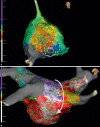[Atypical atrial fibrillation : Diagnostics and therapy]
- PMID: 35986095
- PMCID: PMC9411094
- DOI: 10.1007/s00399-022-00887-3
[Atypical atrial fibrillation : Diagnostics and therapy]
Erratum in
-
Erratum to: Atypical atrial flutter: Diagnostics and therapy.Herzschrittmacherther Elektrophysiol. 2022 Dec;33(4):486. doi: 10.1007/s00399-022-00901-8. Herzschrittmacherther Elektrophysiol. 2022. PMID: 36205786 Free PMC article. No abstract available.
Abstract
In contrast to typical atrial flutter, atypical atrial flutter is a heterogeneous group of right and left atrial macro- or localized reentry tachycardias whose critical component for maintaining tachycardia is not the cavotricuspid isthmus. Atypical atrial flutter occurs more frequently after previous catheter ablation and after cardiac surgery. The intraprocedural success rate during ablation is high, although the recurrence rate depends on structural changes in the atria as well as the underlying mechanism. This article provides an overview of the mechanisms as well as mapping and ablation strategies of the most common forms of right and left atrial atypical atrial flutter. This article is part of the "EP Basics" series for targeted continuing education in invasive electrophysiology. Basics, clinic and therapy of atypical atrial flutter are presented with focus on clinically relevant aspects. Procedures and findings of invasive electrophysiological diagnostics and ablation treatment are the focus of this article.
Im Gegensatz zum typischen Vorhofflattern handelt es sich beim atypischen Vorhofflattern um eine heterogene Gruppe von rechts- und linksatrialen Makro- bzw. Localized-Reentry-Tachykardien, deren kritischer Bestandteil zur Aufrechterhaltung der Tachykardie nicht der cavotrikuspidale Isthmus ist. Atypisches Vorhofflattern tritt gehäuft nach vorangegangener Katheterablation sowie nach herzchirurgischen Eingriffen auf. Die intraprozedurale Erfolgsrate während der Ablation ist hoch, wobei die Rezidivrate von strukturellen Veränderungen der Vorhöfe sowie des zugrundeliegenden Mechanismus abhängig ist. Dieser Artikel bietet einen Überblick über die Mechanismen sowie über Mapping- und Ablationsstrategien der häufigsten Formen von rechts- und linksatrialem atypischem Vorhofflattern. Dieser Beitrag ist Teil der Serie „EP-Basics“ zur gezielten Fortbildung im Bereich Invasive Elektrophysiologie. Grundlagen, Klinik und Therapie des atypischen Vorhofflatterns werden mit Fokus auf klinisch relevante Aspekte dargelegt. Vorgehensweise und Befunde der invasiven elektrophysiologischen Diagnostik und die Ablationsbehandlung bilden den Schwerpunkt dieses Artikels.
Keywords: Anticoagulation; Atrial tachycardia; Cardiac arrhythmia; Catheter ablation; Reentry tachycardia.
© 2022. The Author(s).
References
-
- January CT, Wann LS, Calkins H, Chen LY, Cigarroa JE, Cleveland JC, Jr, Ellinor PT, Ezekowitz MD, Field ME, Furie KL, Heidenreich PA, Murray KT, Shea JB, Tracy CM, Yancy CW. 2019 AHA/ACC/HRS focused update of the 2014 AHA/ACC/HRS guideline for the management of patients with atrial fibrillation: A Report of the American College of Cardiology/American Heart Association Task Force on Clinical Practice Guidelines and the Heart Rhythm Society. Heart Rhythm. 2019;16(8):e66. doi: 10.1016/j.hrthm.2019.01.024. - DOI - PubMed
-
- Rodriguez Ziccardi M, Goyal A, Atrial Flutter MCV. StatPearls Internet. Treasure Island: StatPearls Publishing; 2021. - PubMed
-
- Saoudi N, Cosio F, Waldo A, Chen SA, Iesaka Y, Lesh M, Saksena S, Salerno J, Schoels W. Classification of atrial flutter and regular atrial tachycardia according to electrophysiologic mechanism and anatomic bases: A statement from a joint expert group from the Working Group of Arrhythmias of the European Society of Cardiology and the North American Society of Pacing and Electrophysiology. J Cardiovasc Electrophysiol. 2001;12:852–866. doi: 10.1046/j.1540-8167.2001.00852.x. - DOI - PubMed
-
- Jais P, Matsuo S, Knecht S, Weerasooriya R, Hocini M, Sacher F, Wright M, Nault I, Lellouche N, Klein G, Clementy J, Haissaguerre M. A deductive mapping strategy for atrial tachycardia following atrial fibrillation ablation: importance of localized reentry. J Cardiovasc Electrophysiol. 2009;20:480–491. doi: 10.1111/j.1540-8167.2008.01373.x. - DOI - PubMed
MeSH terms
LinkOut - more resources
Full Text Sources
Medical






